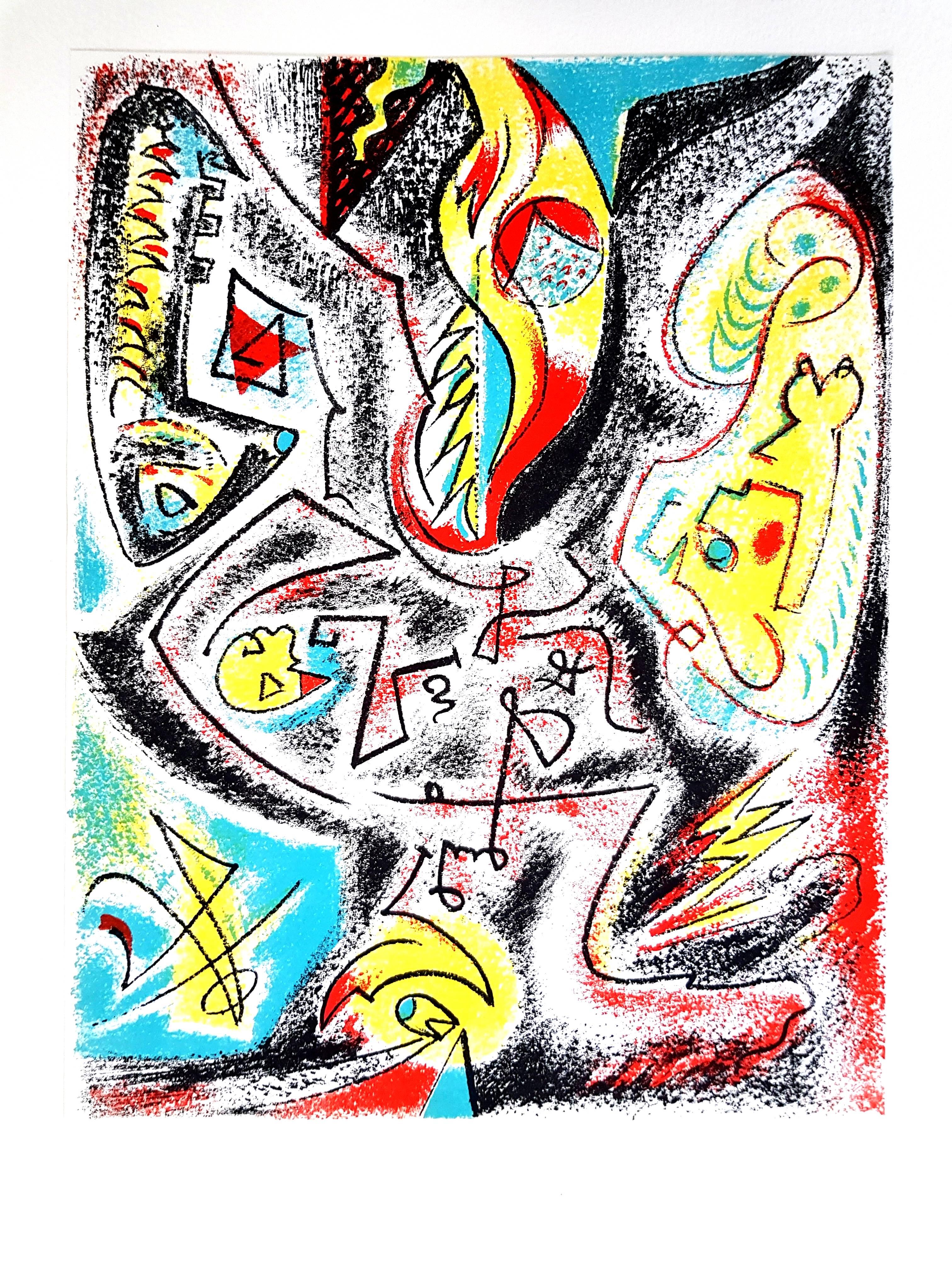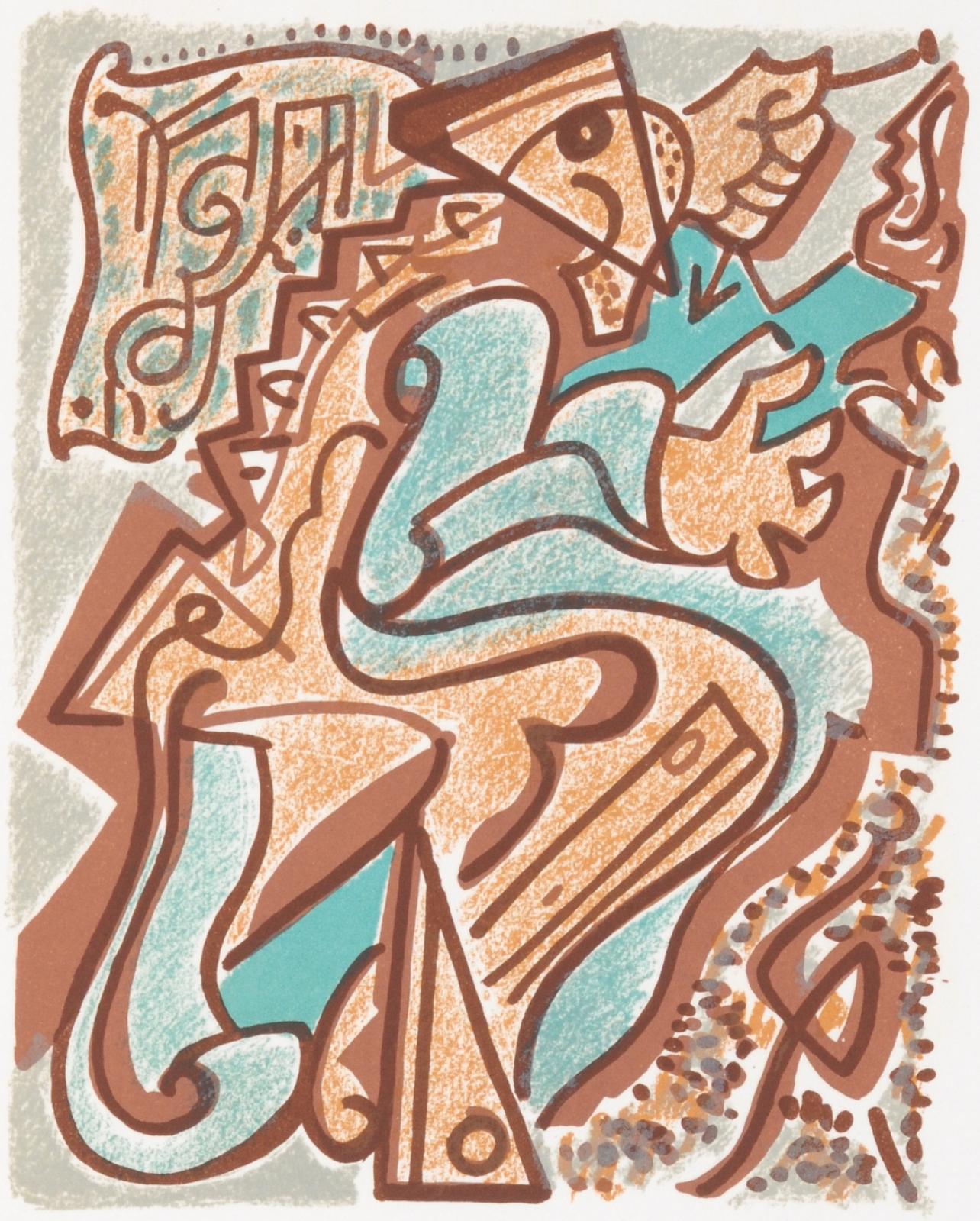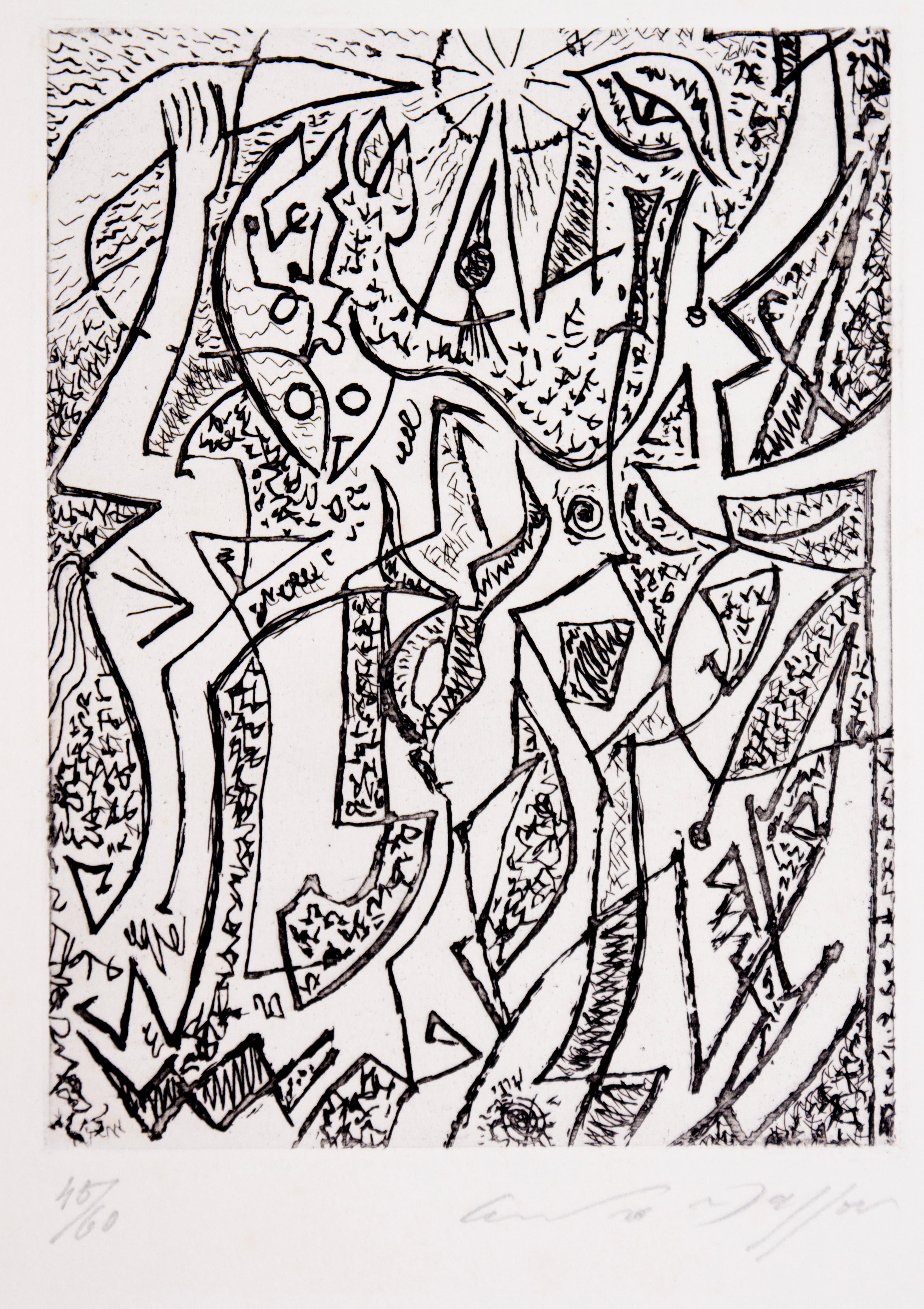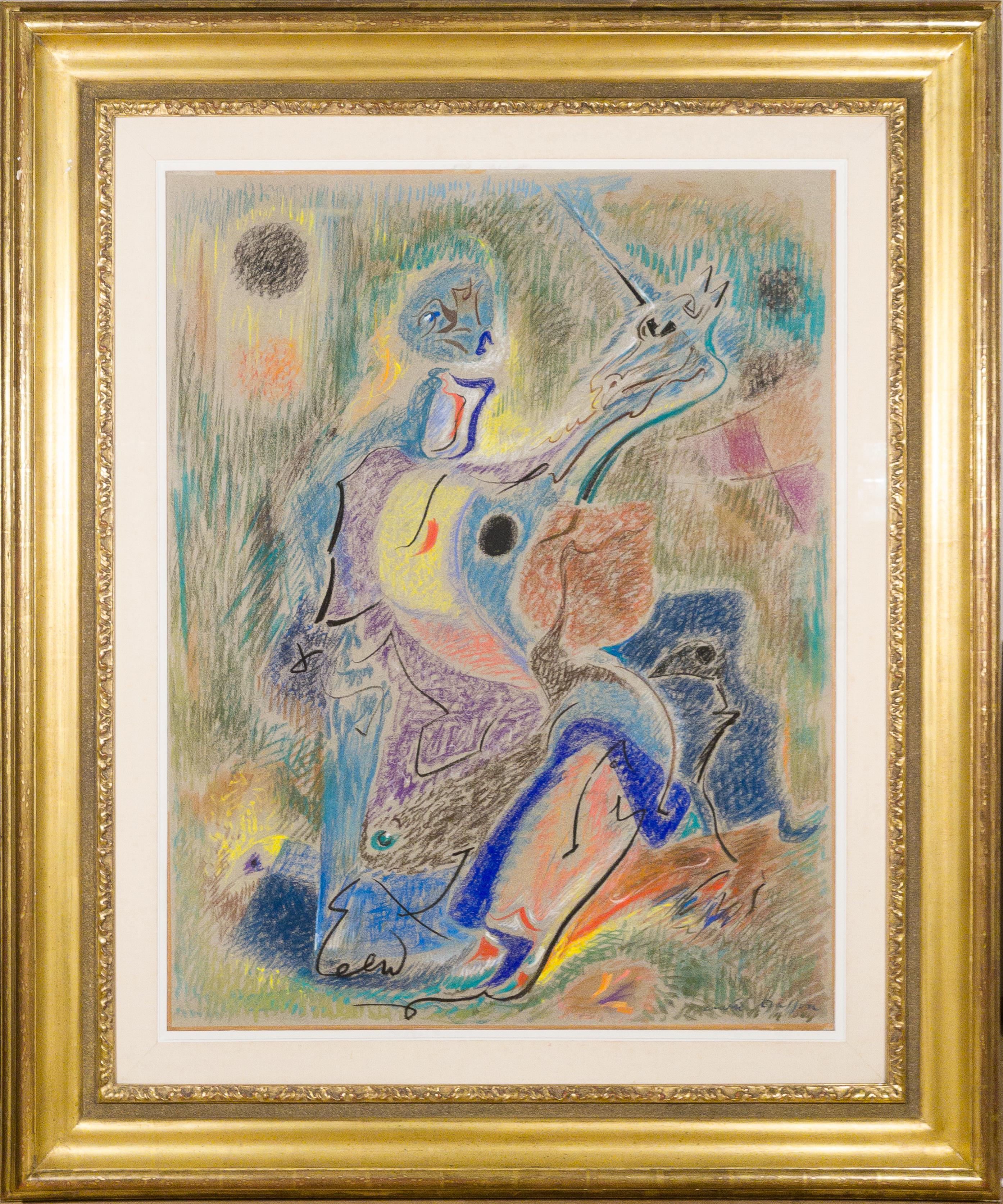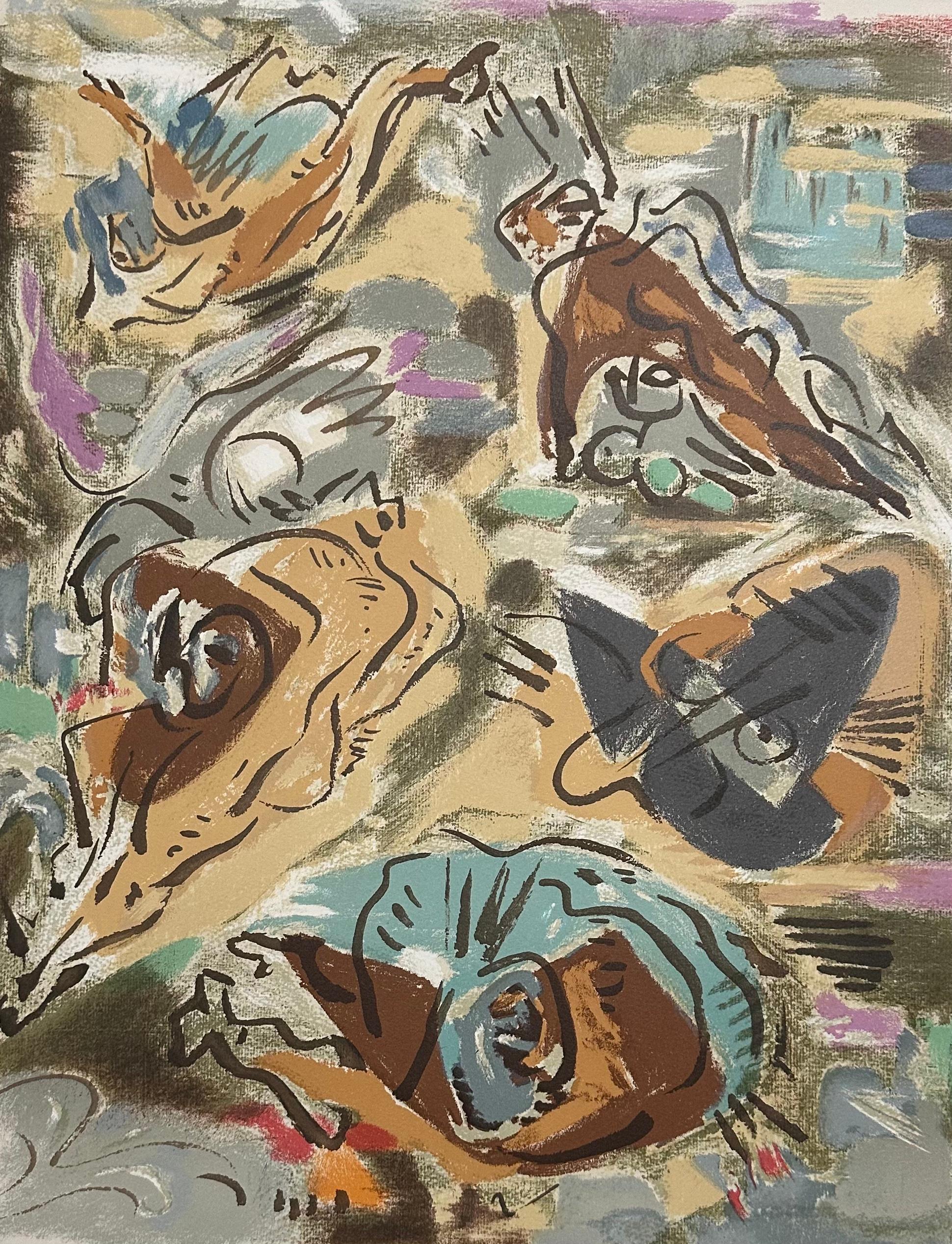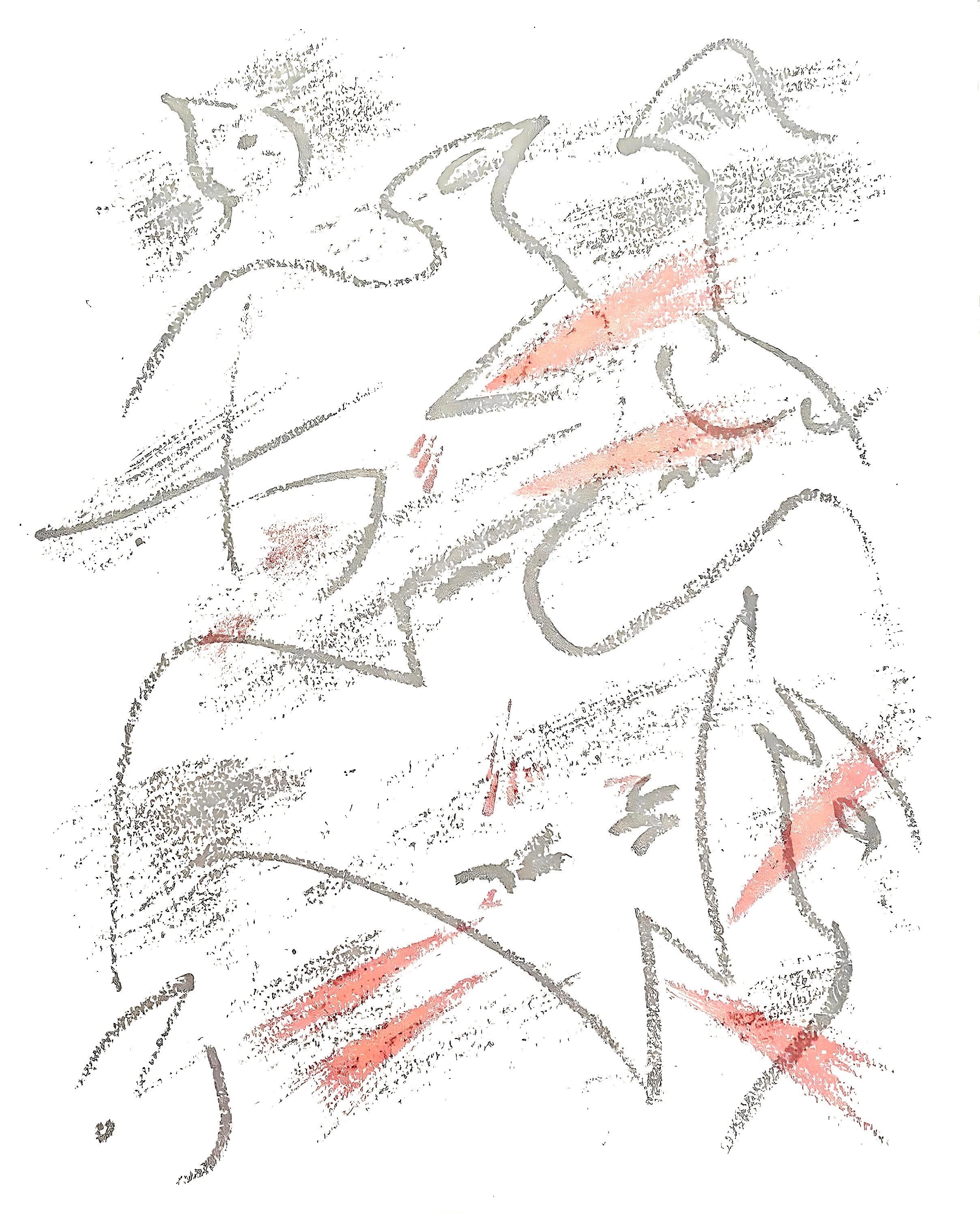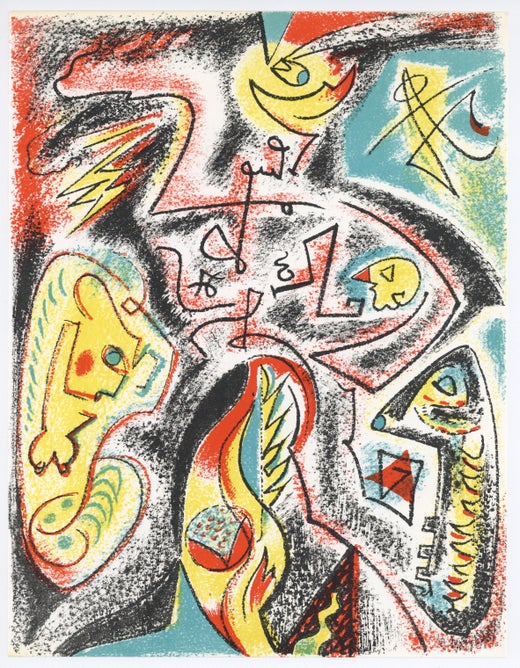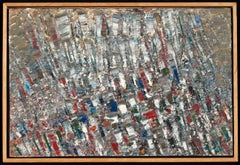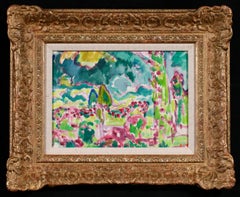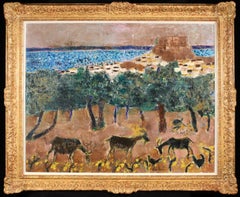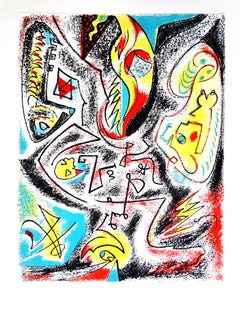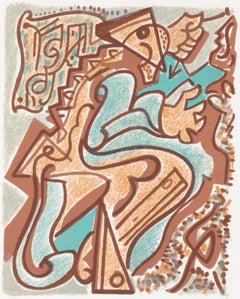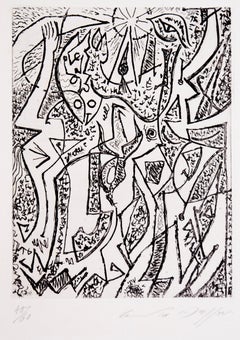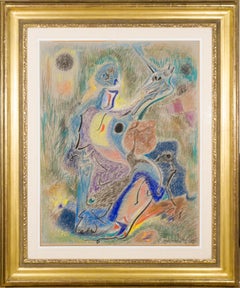Signed, titled and dated cubist oil on canvas by French painter Andre Masson. The work depicts colourful insects.
Signature:
Signed lower right and titled and dated 1946 verso
Dimensions:
Framed: 25"x22"
Unframed: 18"x15"
Provenance:
Galerie Simon - Paris 1946
André Masson came from the region of Compiègne, Beauvais and Senlis. His father sold wallpaper. He lived in Balagny until the age of eight. Following a short stay in Lille his father's work took the family to Brussels, where he attended school until the age of 12. He then became an apprentice, working in the afternoons as a draughtsman in an embroidery studio and studying at the Académie Royale des Beaux-Arts in the mornings and evenings.
Contact with Verhaeren, whom he had met through his master Montald, led the family to send him to Paris around 1912 where he learnt fresco painting. He received a travel scholarship and went to Italy with Loutreuil. During World War I he was seriously injured at Chemin des Dames, in 1917. He was forever affected by the massacres he had witnessed, his injuries and hospitalisation: violence, blood and death were a constant presence in his work.
In 1919 he met up with Loutreuil again, at Étang de Berre and then in Céret, where he met Krémègne and then Soutine. In 1922 he returned to Paris where he had a difficult existence. He struck up friendships with Max Jacob, Élie Lascaux, Artaud, Leiris, Limbour and Miró in 1922-1923, and at that time began to sell paintings. From 1928 he spent part of the year in the south of France. In 1934 he made his first trip to Spain and subsequently settled in Tossa de Mar, Catalonia. When the Spanish Civil War broke out he returned to France in December 1936. In 1940, at the beginning of World War II, he left Paris for Auvergne and then Marseilles, where he met the Surrealists again. In the following year he went to the USA, stopping for three weeks in Martinique on the way, and settled in Connecticut. He returned to France in 1945, moving near Aix-en-Provence in 1947.The traditional works of his earliest youth, in the dawn of the post-war period, were followed by a period influenced by Fauvism and Cézanne. Subsequently, Forests, of 1922, reveal the combined influences of Derain and Rousseau, while a climate of dreams and menace begins to invade these forests which Valéry called 'poisonous' and which Masson himself called 'dream explosions'. After the Forests series, symbolism returned decisively to his work, with Man Underground; Man in a Tower; Prisoner between 1924 and 1926, and Four Elements; Points of the Compass; Constellations. Four Elements was purchased by his associate, André Breton.
From 1924 he took part in the activities of the Surrealists, from whom he broke away briefly from 1929 to 1936. From then, his output was prodigious. He produced his first automatic drawings and truly Surrealist paintings such as Crown and Chevalier in 1924, and Indian ink portraits of the main Surrealist artists and paintings, such as Wandering Women and Armour in 1926. In 1927 he produced his first sand pictures by applying raw materials such as sand and feathers haphazardly, then interpreting the markings obtained, and finally carrying out a controlled reorganisation of these markings to achieve the desired effect. Using this method he produced many works in the years which followed. In 1928 he produced Dead Horses; Villagers; Horses Devouring Birds and Battle of the Fishes. He painted small-scale works Injured Animal; Lady; Meeting in 1929, and in 1931 a series of works on cruel themes such as Young Girls Strangling Birds. In 1934 he produced the series Massacres, a series of etchings on the theme of Sacrifices, and the series Insects; Corridas; Animated Skeletons; Spanish Myths. In 1936 drawings and so-called 'paroxysmic' paintings on the theme of the Spanish Civil War and the series of drawings Mythology of Nature; Mythology of Being appeared. These were followed by paintings and drawings on the themes Metamorphoses, Imaginary Towns, Imaginary Portraits: Goethe and Kleist in 1937, and the paintings of horror and eroticism In the Tower of Sleep; Suicide in a Mirror; Labyrinth; Birth of the Minotaur; Rape, and the very important painting Metamorphosis in 1939. He then produced the series Antilles - Fish Sellers of Martinique, inspired by his stay in Martinique, Cosmic Egg, the first of a series devoted to elemental forces, The Seeded Earth; Meditation on an Oak Leaf; Indian Spring; Iroquois Landscape; Painter at Meditation in 1940, and Imaginary Portraits: Heraclitus; Leonardo da Vinci, and Isabella d'Este; the important painting Pasiphae and several sculptures in 1942-1943.
Paintings, drawings and engravings including The Resistance were inspired by historical events and were produced in 1944-1945, as well as four published albums: Anatomy of my Universe; Mythology of the Being; Nocturnal Notebook and Bestiary, an album of satirical lithographs. He produced paintings on the theme Port of La Rochelle in 1946 and the imaginary paintings Niobe; Men and Chrysalises; Le Terrier; Shadows; Diagrams of a Day, Twenty-two Drawings on the Theme of Desire, produced in just one day, paintings on the theme of the Aix countryside, some reminders of Impressionism, The Mistral; Woman Undressing; Landscape with Precipices; To a Waterfall in 1948-1949.
One of Masson's main pieces of writing, The Pleasure of Painting ( Plaisir de Peindre), was published in 1950, and several albums of lithographs based on sketches from nature, Book of Sketches; From Life; Trip to Venice; Toro, with a preface by Leiris, were published in 1954. He produced the coloured engraving of the series Feminary, many writings, the series of paintings Devoration; Feminary in Rue St-Denis; Multiplied Woman; Migrations in 1956, and the series of paintings Animal Spirits in 1957. In 1959 he abandoned the techniques stemming from automatism, the use of sand, sprinkling material, dripping liquid colours and vaporisation and the production of collages of various raw materials. In 1961-1962 he published Twenty-two Drawings on the Theme of Desire ( Vingt-deux Dessins sur le Thème du Désir), black and coloured lithographs accompanied by a text by Jean Paul Sartre, black engravings for Trophies and painters' texts and paintings on the themes of Mythical Figures; Annals of Nature; Emblematic Places.
As well as his work as a painter, he began to produce sculptures with Giacometti in 1927, returning to the themes and obsessions of his painting. These sculptures included Coupled Animals (1927), Coupled Mantises (1942), Hybris and Masquerade on the Theme of Eros and Thanatos (1964). In 1929 he produced important decorative work for Pierre David Weil, in collaboration with Giacometti. In 1965 he was entrusted with the task of repainting a composition for the cupola ceiling of L'Odéon theatre in Paris. He took a very long time executing this work, producing a great many designs and studies which he began in 1964. He also produced many stage sets including: Les Présages, a ballet by Léonide Massine based on a symphony by Tchaikovsky (1931); Numancia by Cervantes, performed by Jean Louis Barrault's company (1937); La Terre est Ronde by Salacrou, based on a production by Dullin (1938); Hunger by Knut Hamsun, produced at Dullin's theatre by Jean Louis Barrault (1939); Médée, an opera by Darius Milhaud, performed at l'Opéra in Paris (1940); The Victors ( Morts sans Sépulture) by Jean Paul Sartre (1946); Hamlet, performed by the Madeleine Renaud-Jean Louis Barrault company (1946); two ballets by Massine (1951); Iphigenia in Tauris ( Iphigénie en Tauride) by Gluck, performed at Aix-en-Provence festival (1952); Tête d'Or by Claudel, at Théâtre de France (1958); Woyzeck by Berg, produced at l'Opéra in Paris (1963).
He also produced a great many illustrations, including the two drawings, Le Pèse-nerfs (1925); a wood engraving for L'Ombilic des Limbes by Antonin Artaud (1925); seven lithographs for Simulacre by Leiris (1925); drypoint engravings for Soleil Bas by Limbour (1926); etchings for It's the Seven League Boots that phrase 'I See Myself' ( C'est les Bottes de Sept Lieues Cette Phrase: 'Je Me Vois') by Robert Desnos (1927); illustrations for Ximènes Malinjoude by Marcel Jouhandeau (1927) and for Justine by Sade (1928); pastels for Illuminations by Rimbaud (1929); dry-point engravings for L'Anus Solaire by Georges Bataille (1931); etchings for People without Necks ( Les Sans-Cous) by Desnos (1934); lithographs for Glossaire, J'y Serre mes Gloses by Leiris (1939); black lithographs for The Rime of the Ancient Mariner by Coleridge (1948-1949); 33 coloured etchings for The Conquerors ( Les Conquérants) by André Malraux (1949); etchings for Hain-Tenys, Malagasy poems translated by Jean Paulhan, (1955); 16 etchings for Les Europhages by Maurois (1960); coloured lithographs for A Throw of the Dice Will Never Abolish Chance ( Un Coup de Dés Jamais n'Abolira le Hasard) by Mallarmé (1961-1962) and coloured engravings for A Season in Hell ( Une Saison en Enfer) by Rimbaud in 1961-1962.
In 1924 he participated in the first issue of Révolution Surréaliste; the first issue of Minotaur (1933) and on the reviews Acéphale and Minotaur (1934).His work is characterised by its abundance, generosity and diversity, both in the themes and the techniques and by its ease and skill. The obsessional haunting of sex and death pervades all subjects and Georges Bataille, who shared the same obsessions, wrote in his The Tears of Eros ( Larmes d'Éros): 'Masson is one of those painters who has best expressed the profound and agonizing religious values of eroticism.'
Masson's work was already known in the USA before World War II and when he sought refuge there during that war he met Marcel Duchamp, André Breton and other Surrealists and painters such as Fernand Léger, and his intellectual brilliance meant that he had a determining influence on the development of young American painting, particularly on Jackson Pollock and Action Painting. His work has been much discussed and the most commonly held criticism is that he often tried to burden his paintings by endowing them with symbolic literary meanings, thus subordinating the artistic act itself.
Group Exhibitions
1936, International Exhibition of Surrealism, London
1936, Twelve Painters, London
1937, Fantastic Art, Dada, Surrealism, Museum of Modern Art, New York
1938, Exposition Internationale du Surréalisme, Paris (with Mannequin)
1942, First Papers of Surrealism, New York (with There is no Finished World)
1958, Salon de Mai, Paris (with the important work Couple in the Night)
1968, Dada, Surrealism and their Heritage, Museum of Modern Art, New York
2002, La Révolution Surréaliste, Centre Georges-Pompidou, Paris
2003, Phantom of Desire. Visions of Masochism in Art (Phantom der Lust. Visionen des Masochismus in der Kunst), Neue Galerie am Landesmuseum, Graz (an exhibition on Sacher-Masoch, the Austrian novelist who described masochism)
2006, Battlefields (Paysages de Bataille), Musée Départemental, Abbaye de Saint-Riquier (to commemorate the 90th anniversary of the Battle of the Somme, an aesthetic study of the war's effect on the landscape)
2007, Seduced: Art and Sex from Antiquity to Now, Barbican Art Gallery, London
Solo Exhibitions
1933, Massacres series
1936, 1937, 1958, 1962, New York
1941, Museum of Art, Baltimore
1946, Palais des Beaux-Arts, Brussels and Liège
1947, travelling exhibition in UK
1949, drawings from the series Terre érotique, Paris (an exhibition which was closed due to the subject-matter)
1950, Kunsthalle, Basel (with Giacometti)
1955, 1958, London
1956, 1958, 1965, 1981, Musée National d'Art Moderne, Paris
1958, Albertina Museum, Vienna
1958, Tokyo
1958, Venice Biennale
1959, Rome
1961, Chicago
1964, Akademie der Künste, Berlin
1964, Stedelijk Museum, Amsterdam
1965, Bremen
1967, Musée des Beaux-Arts, Lyons
1968, musée Cantini, Marseilles
1968, recent paintings and a series of 12 drawings, Mythical Autobiography
1969, Palazzo dei Diamanti, Ferrara
1975, Musée d'Aix-en-Provence
1976, MOMA, New York, and the Museum of Fine Arts, Houston
1985, Fondation Royaumont and Musée des Beaux-Arts, Nîmes
1987, André Masson. Automatismes, Chapelle de la Sorbonne, Paris (a few months before his death)
1987, André Masson, Line Unleashed: A Retrospective Exhibition of Drawings, Hayward Gallery, London
1988, André Masson, 70 Œuvres Gravées, Peter Stuyvesant foundation, Amsterdam and an exhibition at the Grand Palais in Paris
1990, André Masson, Œuvres de 1954 à 1974, Centre Culturel, Issoire
1990, André Masson, Œuvres Maîtresses, Galerie H. Odermatt & Ph. Cazeau, Paris
1992, André Masson en España, 1933-1943, Centro de Exposiciones y Congresos in Saragossa
1993, Masson. Bataille, Musée des Beaux-Arts, Orléans
1995, André Masson, 1947-1960, Signes et Lumières, Espace 13 Art Contemporain, Aix-en-Provence
1996, Masson: Massacres, Métamorphoses, Mythologies, Musée des Beaux-Arts, Bern
1996, André Masson in America, 1941-1945, Zabriskie Gallery, Paris
1998, André Masson, Rebell des Surrealismus, Ludwig museum, Koblenz
1998, André Masson, un Combat, Peintures, Dessins, Sculptures, Musée de la Cour d'Or, Metz
2002, Masson/Massacres, Historial de la Grande Guerre, Château de Péronne (a presentation of the Massacres series)
2002, André Masson, le Songe Érotique, Espace Carole Brimaud, Paris
Museum and Gallery Holdings
Amiens (FRAC Picardie): Couple in the Night (1958)
Baltimore (MA): In the Tower of Sleep (1938); There is no Finished World (1942)
Bern (Kunstmus.): Fishes Drawn in Sand
Grenoble: Cemetery (1924); Improvement (1956)
London (Tate Collection): Ibdes in Aragon (1935, oil on canvas)
Marseilles (Mus. Cantini): Antille (1943); Terrier (1946); The Mélusine Sisters (1958); Napoleon's Soul (1967); Diana and Endymion
New York (MoMA): Figure; Sand (1927); Leonardo da Vinci and Isabella d'Este (1942)
Paris (BNF): About Flowers (1977, etching)
Paris (MAMVP): Painting; Pretenders; Abduction
Paris (MNAM-CCI): Portrait of André Breton (1941); The Four Elements (1923-1924); Dead Horses (1927); Jet of Blood (1936); Entanglement (1941); Pythia (1943); Blood of Birds (1956)
Venice (Collezione Peggy Guggenheim): Armour (1925)
